Chesley Sullenberger
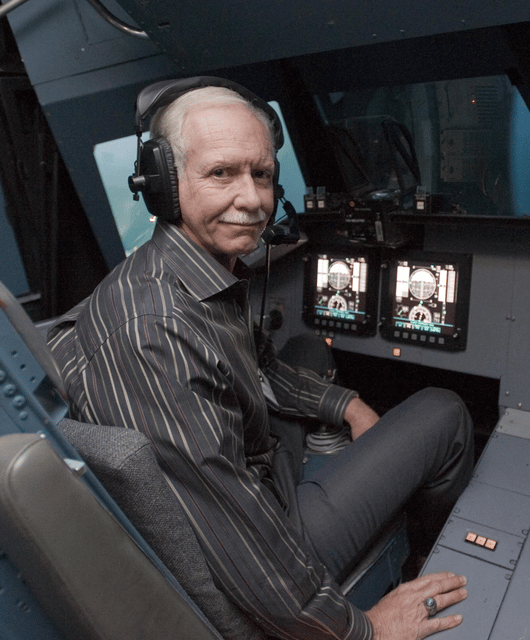
Chesley Sullenberger

Chesley
Sullenberger | |
|---|---|
| Born | Chesley Burnett Sullenberger (1951-01-23)January 23, 1951 Denison, Texas, U.S. |
| Education | United States Air Force Academy (BS) Purdue University, West Lafayette (MS) University of Northern Colorado, Greeley (MPA) |
| Known for | Water landing of US Airways Flight 1549 on the Hudson River |
| Spouse(s) | Lorrie Sullenberger |
| Children | 2 |
| Awards | Time's 100 Most Influential Heroes and Icons (2009) Master's Medal from the Guild of Air Pilots and Air Navigators Key to the City from New York City Chris Matthews' Hardball Award Legion of Honour (Officier) Outstanding Cadet in Airmanship Jabara Award |
| Military career | |
| Allegiance | |
| Service/ | |
| Rank | |
Chesley Burnett "Sully" Sullenberger III (born January 23, 1951) is an American retired airline captain who, on January 15, 2009, landed US Airways Flight 1549 in the Hudson River off Manhattan after both engines were disabled by a bird strike; all 155 people aboard survived. Sullenberger is a speaker on airline safety[1] and has helped develop new protocols for airline safety. He served as the co-chairman, along with first officer Jeffrey Skiles, of the Experimental Aircraft Association (EAA)'s Young Eagles youth introduction-to-aviation program from 2009 to 2013.[2]
Sullenberger is the co-author, with Jeffrey Zaslow, of the New York Times bestseller Highest Duty: My Search for What Really Matters, a memoir of his life and of the events surrounding Flight 1549, published in 2009 by HarperCollins. His second book, Making a Difference: Stories of Vision and Courage from America's Leaders, was published in May 2012. He was ranked second in Time's Top 100 Most Influential Heroes and Icons of 2009, after Michelle Obama.[5]
Chesley
Sullenberger | |
|---|---|
| Born | Chesley Burnett Sullenberger (1951-01-23)January 23, 1951 Denison, Texas, U.S. |
| Education | United States Air Force Academy (BS) Purdue University, West Lafayette (MS) University of Northern Colorado, Greeley (MPA) |
| Known for | Water landing of US Airways Flight 1549 on the Hudson River |
| Spouse(s) | Lorrie Sullenberger |
| Children | 2 |
| Awards | Time's 100 Most Influential Heroes and Icons (2009) Master's Medal from the Guild of Air Pilots and Air Navigators Key to the City from New York City Chris Matthews' Hardball Award Legion of Honour (Officier) Outstanding Cadet in Airmanship Jabara Award |
| Military career | |
| Allegiance | |
| Service/ | |
| Rank | |
Early life
Chesley Sullenberger was born in Denison, Texas.[6] His father was a descendant of Swiss-German immigrants named Sollenberger.[7] He has one sister, Mary. The street on which he grew up in Denison was named after his mother's family. According to his sister, Sullenberger built model planes and aircraft carriers during his childhood, and says he became interested in flying after seeing military jets from an Air Force base near his house.[8] He went to school in Denison, and was consistently on the 99th percentile in every academic category.[9]
At the age of 12, his IQ was deemed high enough to join Mensa International.[9] In high school, he was the president of the Latin club, a first chair flutist, and an honor student.[10] He was an active member of the Waples Memorial United Methodist Church in Denison.[11] He graduated from Denison High School in 1969,[10] near the top of his class of about 350.[8] At 16, Sullenberger learned to fly in an Aeronca 7DC from a private airstrip near his home. He said the training he received from a local flight instructor influenced his aviation career for the rest of his life.[12]
Post-secondary education
Sullenberger earned a Bachelor of Science degree from the United States Air Force Academy. He also earned a master's degree in industrial psychology from Purdue University and a master's degree in public administration from the University of Northern Colorado.[13]
Military service
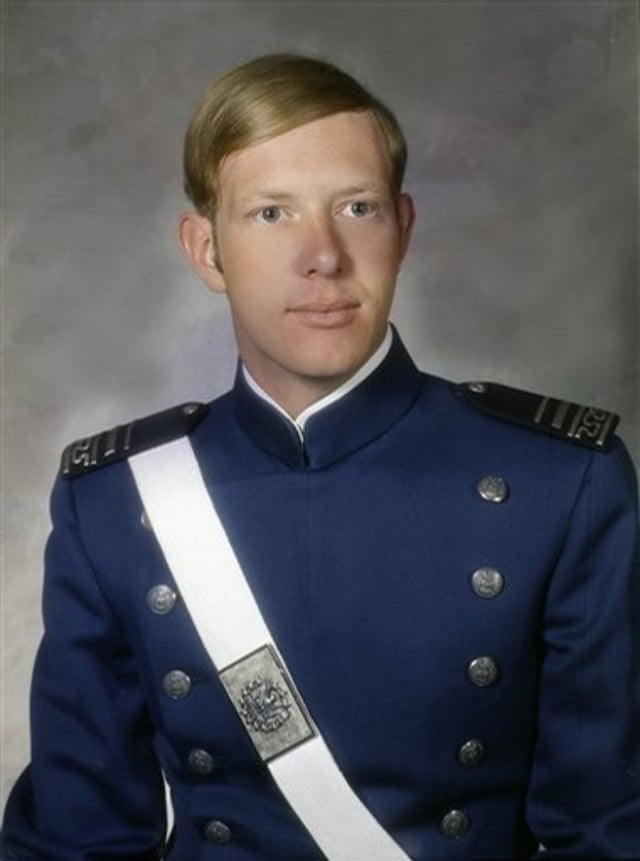
Sullenberger's 1973 Air Force Academy senior class photograph
Sullenberger was appointed to the United States Air Force Academy, entering with the Class of 1973 in June 1969. He was selected along with around a dozen other freshmen for a cadet glider program, and by the end of that year, he was an instructor pilot.[8] In the year of his graduation, 1973, he received the Outstanding Cadet in Airmanship award, as the class "top flyer". Following graduation with a Bachelor of Science and his commissioning as an officer, the Air Force immediately sent Sullenberger to Purdue University to pursue a master's degree prior to entering Undergraduate Pilot Training (UPT).[14]
Following completion of his graduate degree at Purdue, he was assigned to UPT at Columbus AFB, Mississippi, flying the T-37 Tweet and T-38 Talon. After earning his wings in 1975 as a USAF Pilot, he completed replacement training in the F-4 Phantom II at Luke AFB, Arizona. This was followed by his assignment to the 493d Tactical Fighter Squadron of 48th Tactical Fighter Wing at RAF Lakenheath, United Kingdom, where he flew as a United States Air Force fighter pilot[15] in the F-4D Phantom II.
Following his assignment at RAF Lakenheath, he was reassigned to the 428th Tactical Fighter Squadron of the 474th Tactical Fighter Wing at Nellis AFB, Nevada, again flying the F-4D.[16][17] He advanced to become a flight leader and a training officer, and attained the rank of captain,[13] with experience in Europe, the Pacific, and at Nellis Air Force Base, as well as operating as Blue Force Mission Commander in Red Flag Exercises.[17] While in the Air Force, he was a member of an aircraft accident investigation board.[18]
Civil aviation career
Sullenberger was employed by US Airways and its predecessor airlines from 1980 until 2010.[3][19][20] (Pacific Southwest Airlines was acquired by US Air, later US Airways, in 1988.) He holds an airline transport pilot certificate for single and multi-engine airplanes, a commercial pilot license rating in gliders, as well as a flight instructor certificate for airplanes (single, multi-engine, and instrument) and gliders.[21] In total, he has more than 40 years and 20,000 hours of flying experience. In 2007,[13] he became the founder and CEO of Safety Reliability Methods, Inc. (SRM), a firm providing strategic and tactical guidance to enhance organizational safety, performance, and reliability.[22]
He has also been involved in a number of accident investigations conducted by the USAF and the National Transportation Safety Board (NTSB), such as Pacific Southwest Airlines Flight 1771 and USAir Flight 1493.[23] He served as an instructor, Air Line Pilots Association Local Air Safety Chairman, accident investigator, and national technical committee member.[15][24] His safety work for ALPA led to the development of a Federal Aviation Administration Advisory Circular.[17] He was instrumental in developing and implementing the Crew Resource Management course that is used by US Airways, and he has taught the course to hundreds of airline crew members.[17][25]
Working with NASA scientists, he coauthored a paper on error-inducing contexts in aviation.[17] He was an air accident investigator for an NTSB inquiry into a major accident at Los Angeles International Airport, which "led to improved airline procedures and training for emergency evacuations of aircraft."[18] Sullenberger has also been studying the psychology behind keeping an airline crew functioning during a crisis.[26]
He was a featured speaker for two panels: one on aviation and one on patient safety in medicine, at the High Reliability Organizations (HRO) 2007 International Conference in Deauville, France, from May 29 to 31, 2007.[27]
Flight 1549

US Airways Flight 1549 afloat in the Hudson River
On January 15, 2009, Sullenberger was the captain of US Airways Flight 1549, an Airbus A320 taking off from LaGuardia Airport in New York City.[28] Shortly after takeoff, the plane struck a flock of Canada geese and lost power in both engines.[29] Quickly determining he would be unable to reach either LaGuardia or Teterboro airport,[30] Sullenberger piloted the plane to a water landing on the Hudson River. All 155 people on board survived and were rescued by nearby boats.[31]
Sullenberger said later: "It was very quiet as we worked, my copilot Jeff Skiles and I. We were a team. But to have zero thrust coming out of those engines was shocking—the silence."[32] Sullenberger was the last to leave the aircraft, after twice making sweeps through the cabin to make sure all passengers and crew had evacuated.[8][33]
Sullenberger, described by friends as "shy and reticent,"[34] was noted for his poise and calm during the crisis; New York City Mayor Michael Bloomberg dubbed him "Captain Cool".[35] Nonetheless, Sullenberger suffered symptoms of post-traumatic stress disorder in subsequent weeks, including sleeplessness and flashbacks.[36] He said that the moments before the ditching were "the worst sickening, pit-of-your-stomach, falling-through-the-floor feeling" that he had ever experienced.[37] He also said: "One way of looking at this might be that for 42 years, I've been making small, regular deposits in this bank of experience, education and training. And on January 15, the balance was sufficient so that I could make a very large withdrawal."[38]
The National Transportation Safety Board ruled that Sullenberger made the correct decision in landing on the river instead of attempting a return to LaGuardia[39] because the normal procedures for engine loss are designed for cruising altitudes, not immediately after takeoff. Simulations performed at the Airbus Training Centre Europe in Toulouse showed that Flight 1549 could have made it back to LaGuardia had that maneuver begun immediately after the bird strike. However, such scenarios both neglected the time necessary for the pilots to understand and assess the situation, and risked the possibility of a crash within a densely populated area.[40][41]
Post-flight accolades and publicity
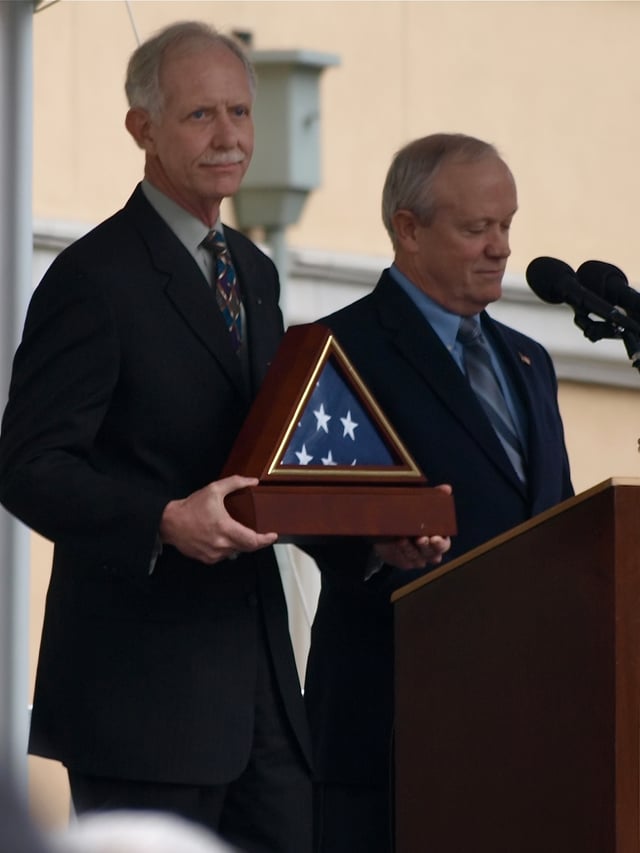
Congressman Jerry McNerney presenting Sullenberger with a framed flag on January 24, 2009
U.S. President George W. Bush called Sullenberger to thank him for saving the lives of the passengers,[42] as did President-elect Barack Obama,[43] who also invited him and the crew to join the presidential inauguration ceremony.[44] On January 16, 2009, the United States Senate passed a resolution recognizing and honoring Sullenberger, Skiles, the cabin crew, the passengers, and the first responders involved in Flight 1549's emergency landing.[45] The United States House of Representatives passed a similar resolution on January 26, 2009.[46]
Sullenberger attended the presidential inauguration on January 20, 2009, where he and his wife met President Obama.[36] On January 22, 2009, he and the rest of the crew of Flight 1549 were awarded a Masters Medal by the Guild of Air Pilots and Air Navigators.[47] A ceremony for Sullenberger was held on January 24, 2009, in Sullenberger's hometown of Danville, California, where he was presented with awards including Danville's "Key to the Town",[34] and was named an honorary Danville police officer.[48] While in the Tri-Valley, Sullenberger decided to grant his first official interview to Jega Sanmugam of The Wildcat Tribune,[49] the official student newspaper of Dougherty Valley High School, which his daughter attended at the time.[50] In a special February 2009 edition, the Tribune published "Heroism & Humility on the Hudson," covering Sullenberger and the Flight 1549 landing.[50]
San Ramon Valley Fire Protection District Chief Richard Price presented Captain Sullenberger with his district's highest award, the Medal of Valor,[51] which has been given only a few times in the district's history.[52] Sullenberger, Skiles, and Flight 1549's cabin crew, Doreen Welsh, Sheila Dail and Donna Dent, were honored with a standing ovation during the Super Bowl XLIII pre-game ceremony on February 1, 2009.[53] Sullenberger was awarded with honorary lifetime membership in the Seaplane Pilots Association.[54] In 2009, Sullenberger was awarded the Founders' Medal by The Air League.[55] Admirers of Sullenberger also started a Facebook fan site that, as of late February 2009, had half a million members.[36]
A library book, Just Culture: Balancing Safety and Accountability was in Sullenberger's luggage left behind in the cockpit. When Sullenberger notified the library that the water-damaged book had been recovered, it made a point of waiving any late fees. Bloomberg presented Sullenberger with a new copy along with the Key to the City of New York.[56][57][58]
Sullenberger threw out the first pitch of the 2009 Major League Baseball season for the San Francisco Giants. His Giants jersey was inscribed with the name "Sully" and the number 155—a reference to the 155 people aboard the plane.[59]
On June 6, 2009, Sullenberger returned to his childhood hometown of Denison, Texas, to participate in the town's D-Day celebration, and to give the commencement address for his alma mater, Denison High School, marking the 40th anniversary of his own graduation from the school.[60]
Sullenberger also made an appearance in St. Louis, Missouri, on July 14, 2009, to participate in the Red Carpet All-Star Parade before the 2009 Major League Baseball All-Star Game.
On February 24, 2009, Sullenberger testified before the U.S. House of Representatives Subcommittee on Aviation of the Committee on Transportation & Infrastructure that his salary had been cut by 40 percent, and that his pension, like most airline pensions, was terminated and replaced by a PBGC guarantee worth only pennies on the dollar.[61] He cautioned that airlines were "under pressure to hire people with less experience. Their salaries are so low that people with greater experience will not take those jobs. We have some carriers that have hired some pilots with only a few hundred hours of experience. ... There’s simply no substitute for experience in terms of aviation safety."[62]
Retirement and subsequent career
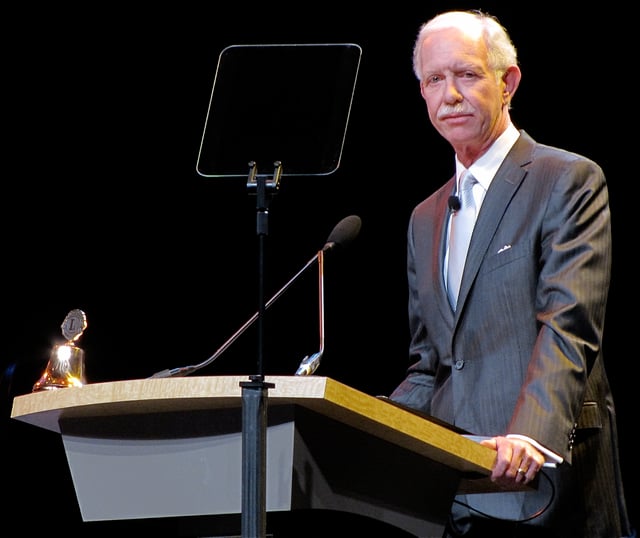
Sullenberger at the LIONS World Convention 2010 in Sydney
After 30 years with US Airways and its predecessor, Sullenberger retired in 2010. His final flight was US Airways Flight 1167 from Fort Lauderdale, Florida, to Charlotte, North Carolina, where he was reunited with his copilot Jeff Skiles and a half dozen of the passengers on Flight 1549.[62]
Sullenberger is an international lecturer and keynote speaker at educational institutions, corporations and non-profit organizations about the importance of aviation and patient safety, high performance systems improvement, leadership and culture, risk and crisis management, life-long preparation, and living a life of integrity. He presented at the World Economic Forum in Davos in 2011, as well as the Swiss Economic Forum that same year.[63]
He was also the 2010 Tournament of Roses Parade's Grand Marshal.[64]
In 2011, as part of a fundraising effort, Sullenberger flew to the Carolinas Aviation Museum in Charlotte, North Carolina, where the aircraft he landed on the Hudson River is on exhibit.[65]
In December 2010, Sullenberger was appointed an Officer of France's Legion of Honour.[66][67]
With coauthor Jeffrey Zaslow, Sullenberger wrote the 2009 bestselling memoir Highest Duty: My Search for What Really Matters. In the book, Sullenberger also discusses personal matters including his father's suicide in 1995, the Sullenbergers' struggle with infertility, and their decision to adopt.[68][69]
Sullenberger's second book, Making a Difference: Stories of Vision and Courage from America's Leaders, was released on May 15, 2012.
Personal life
Sullenberger is married to fitness instructor Lorraine "Lorrie" Sullenberger,[31] with whom he adopted[70] two daughters,[18] Kate and Kelly.[71]&p_field_advanced-0=title&p_text_advanced-0=(%22experienced%20pilot%22%29&p_bool_advanced-1=OR&p_field_advanced-1=Lead&p_text_advanced-1=(%22experienced%20pilot%22%29&xcal_numdocs=20&p_perpage=10&p_sort=YMD_date:D&xcal_useweights=no)
On December 7, 1995, Sullenberger's father committed suicide by gunshot shortly after being released from the hospital following major surgery. He had been suffering from depression in the face of a long and difficult convalescence ahead of him. He left no note. As a result of this, Sullenberger became a suicide prevention activist, having promoted National Suicide Prevention Week and National Suicide Prevention Lifeline.[68][69]
Politics
In October 2009, it was reported that the Republican Party had approached Sullenberger about running against Democratic U.S. Representative Jerry McNerney of California's 11th congressional district in the 2010 elections. Sullenberger's publicist said that he had no desire to run for public office.[72]
In late October 2018, Sullenberger wrote an op-ed in The Washington Post ahead of the 2018 mid-term elections, calling on Americans to vote “for leaders who are committed to the values that will unite and protect us”,[73] who would show “moral compass ... competence, integrity, and concern for the greater good”.[74] In a subsequent interview with Lawrence O'Donnell, Sullenberger elaborated his position, discussing his belief that voters should act as a check and balance in a partisan government.[75]
In popular culture
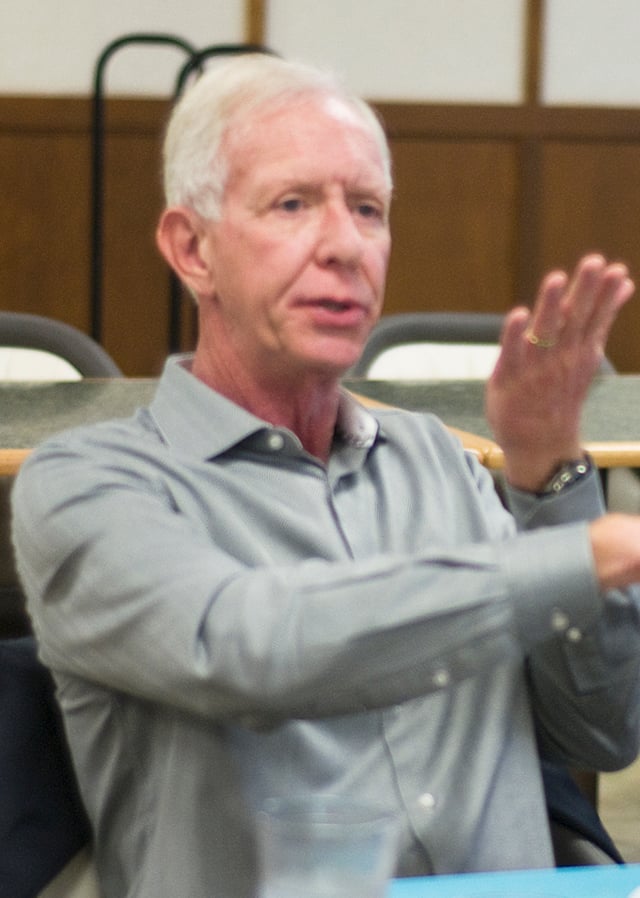
Sullenberger in 2014
The 2016 dramatic feature film Sully[76] was adapted from Sullenberger's memoir Highest Duty: My Search for What Really Matters. Directed by Clint Eastwood and starring Tom Hanks as Chesley Sullenberger,[77] it recreates the events around the Hudson River landing.
Sullenberger's speech before Congress concerning U.S. civil aviation is featured in Michael Moore's 2009 documentary Capitalism: A Love Story.
Sullenberger is also referred to in the 2011 romantic comedy film Friends with Benefits. Throughout the film, Justin Timberlake's character repeatedly suggests to people he meets aboard planes that modern airplanes practically fly themselves, and that Sullenberger's feat was less impressive than it was portrayed, an idea for which he encounters incredulity and hostility. Mila Kunis' character is also seen reading Sullenberger's English Wikipedia article.[78][79][80]
The 2010 song "A Real Hero", by French electronica artist College and the band Electric Youth, is about Captain Sullenberger and the Flight 1549 water landing. Frontman Austin Garrick was inspired to write the song by his grandfather, whose reference to Sullenberger as "a real human being and a real hero" became the song's refrain.[81]
Radio personality Garrison Keillor wrote "Pilot Song: The Ballad of Chesley Sullenberger III" for the January 17, 2009 edition of his radio variety show A Prairie Home Companion.
Sullenberger appeared as himself in a cameo role in the 2017 film Daddy's Home 2.
"Hudson River Runway", the March 14, 2011, episode of the TV series Mayday, documents the events around Flight 1549's emergency landing, and contains interviews with several of its real-life participants. Captain Sullenberger is not interviewed in the show, but is portrayed in reenactments by actor Christopher Britton.[82]
An animated version of Sullenberger appeared in "The Unbrave One", the January 8, 2012, episode of the animated TV show American Dad![83]
Matt Damon portrays an airline pilot in the February 10, 2011 episode of the NBC TV comedy 30 Rock, in which he brags that a great pilot like him does not land on the Hudson River but avoids hitting birds altogether.[84]
President George H. W. Bush's service dog Sully, who was assigned to Bush in mid-2018 after the death of Bush's wife Barbara, was named after Sullenberger.[85]
In 2018, the eleventh episode of Comedians in Cars Getting Coffee' tenth season, Alec Baldwin compliments Jerry Seinfeld on his driving skill and says that Jerry is the Sully Sullenberger of television driving.
